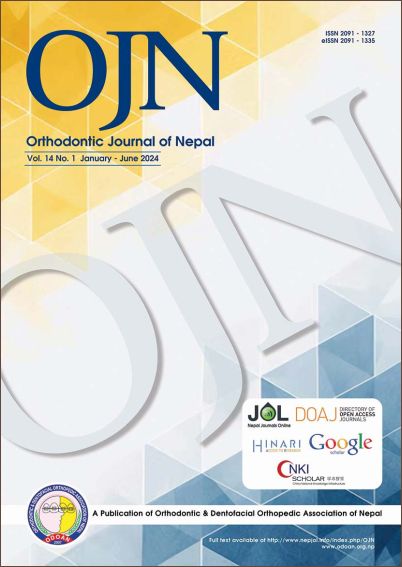Phenotypic Characterization of Skeletal Class III Malocclusion Using Principal Component Analysis and Cluster Analysis
Article text
DOI:
https://doi.org/10.3126/ojn.v14i1.62788Keywords:
Class III malocclusion, Cluster analysis, Multivariate reduction analyses, Phenotypes, Principal component analysisAbstract
Background: Skeletal Class III malocclusion is characterized by several dentofacial deformities linked to environmental and genetic causes. It constitutes a clinical obstacle due to an insufficient understanding of its origins. Thus, proper classification and definition are key to diagnosing and treating this malocclusion correctly.
Objective: This study aimed to identify sub-clusters of skeletal Class III malocclusion in a group of Yemeni adults using multivariate reduction analyses.
Design: This cross-sectional prospective study was conducted at the Orthodontic Graduate Clinics, Faculty of Dentistry, Sana`a University, Sana`a, Yemen.
Material and Methods: This study included lateral cephalometric radiographs of 144 Yemeni adults (67 males and 77 females, mean age 29 years) with true Class III skeletal malocclusion ranging from mild to severe. A total of 62 measurements were used to perform principal component analyses and subsequent cluster analyses.
Results: Eight principal components were identified and represented 79.4% of the variance. The fist three main components, which described vertical and sagittal variables as significant descriptors, explained 50.8% of the variance. Cluster analysis identified 5 phenotypic subclusters. Cluster 1 denoted a mild Class III phenotype. Cluster 2 displayed a vertical phenotype with a steep mandibular plane. Cluster 3 displayed a phenotype characterized by a purely severe mandibular prognathism. Cluster 4 showed a severe maxillary retrusion phenotype. Cluster 5 displayed a severe maxillary deficiency with a severe mandibular protrusion.
Conclusion: There was a significant variance demonstrated among sub-phenotypes of a selected group of adult Yemeni Class III populations. Based on these results, further genetic investigations will enable us to uncover the etiological genes associated with each sub-cluster.
Downloads
Downloads
Published
How to Cite
Issue
Section
License
Copyright (c) 2024 Orthodontic & Dentofacial Orthopedic Association of Nepal

This work is licensed under a Creative Commons Attribution 4.0 International License.
Copyright © held by Orthodontic & Dentofacial Orthopedic Association of Nepal
- Copyright on any research article is transferred in full to the Orthodontic & Dentofacial Orthopedic Association of Nepal upon publication in the journal. The copyright transfer includes the right to reproduce and distribute the article in any form of reproduction (printing, electronic media or any other form).
- Articles in the Orthodontic Journal of Nepal are Open Access articles published under the Creative Commons CC BY License (https://creativecommons.org/licenses/by/4.0/)
- This license permits use, distribution and reproduction in any medium, provided the original work is properly cited.




